Explorations in Shorne Woods: Archaeology in Action
This post has been cross posted from our blog DRAGEN Tales.
The Brew House at the Randall Manor
During their time in Gravesend, UK, members of our team visited Shorne Woods County Park in Kent to see Randall Manor with Andrew Mayfield, Community Archaeologist with Heritage Conservation Group, Kent County Council. The Randall Manor is a medieval manor house that was the focal point of a 10-year archaeology excavation funded by a Heritage Lottery Fund from 2006 to 2015. During this excursion to Shorne Woods, the team learned of a group of 10-15 volunteer archaeologists who work with the Heritage Conservation in Kent to dig “test pits” with the goal of discovering different finds throughout the park.
A piece of fascinating history that our team learned of the area which the park is located, is that it was previously occupied by a 300-year old clay mine that was used by a cement company from 1930-1970. The use of this clay excavation site directly supported war efforts during its time, until its demise in the 1970’s when it was acquired by the Kent County Council and eventually turned into a nature area. At the time of its abandonment, various items of machinery and war-time artifacts were left behind. Some were later unearthed by archaeologists who dug test pits in Shorne Woods, and are in collections storage or on display in the community centre located on the property. This public space is quite beautiful to walk through, and it’s diverse historical contexts is appealing to explore further. Other finds in this area emphasized the existence of a Mesolithic settlement in the space as well.
While visiting the site, the team witnessed fist-hand the excitement of archaeologists in action as a find has been unearthed. While encountering the volunteer archaeologists, they informed us of a recent discovery of churt structural remains that would have been an unknown building, as well as adjoining roof tile that belonged to the structure. At that time, the archaeologists predicted that the structure would have been used for something like storage, or a barn to keep animals. This was determined as there were no further items discovered on the site via test pits.
Having an opportunity to explore Shorne Woods was incredibly beneficial for members of the team, as it provided different contexts and historical findings that allowed for reflection and discussion amongst the various backgrounds of everyone. Experiencing archaeology unfold first-hand and discussing findings with those in the field allowed for our team, across their various disciplines and research interests, to learn about identification and evaluation of environments. Exploring the incredible historic contexts of this public space opened various windows of interest and opportunity for those who had the opportunity to attend.

